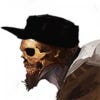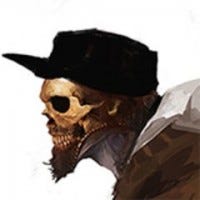
Featured Blog | This community-written post highlights the best of what the game industry has to offer. Read more like it on the Game Developer Blogs.
Crafting Nightmares - Othercide's Art Direction
Finding the "soul" for Othercide's art direction was a thrilling journey. Born from our own traumas, here is how we tried to make our game stand out from the tactical genre.

"From their lair of darkness, the Others feed from our nightmares…"
In a dark ethereal world, fighting in the ruins of a broken City, a group of fierce warriors stand to prevent Reality from Shattering. Through pain, sacrifice and blood splatters, the Daughters will go through the twisted realms of the Dark Corner and confront the horrible creatures of the Suffering Other.
Will you succeed in stopping the tortured creator of those monstrosities known as the Child?
What will you be able to sacrifice to reach your goal…? Will you be able to dig all the hidden secrets laying behind the curtains of reality?
This is Othercide, a tactical RPG, where epic battles tell personal tales of fear and suffering. But that’s only the tip of the iceberg.
My name is Alex Chaudret, I have been working in the video games industry since 2011, and I joined Lightbulb Crew as an Art Director in September 2017. When I arrived in the studio, Othercide was still in a very early stage - it wasn’t even called Othercide yet! - and I had no idea how stimulating (and exhausting!) this journey would end up being, both creatively and emotionally…
It was (and it still is) my first official job as an Art Director, and even though I wanted to be confident and brave, I had in fact no idea what I was stepping in. I just had a very clear mission: make Othercide stand out "artistically" from the tactical genre, and establish a strong, coherent art direction for the project and the company.
"You just have to trust your own madness." - Clive Barker

Illustration by Marine Coiffard / Art Direction by Alexandre Chaudret
Dark Inspirations
When I started, Othercide had already entered preproduction a few months ago; there had been lots of ideas explored, different styles tried out, but it ended up being too close to the "XCOM" aesthetics still. It was time to try a different approach, so we set out to define a creative framework, an "art system" with a handful of clear, bold aesthetic rules we would be working with. These rules created strong boundaries that immediately structured the way we thought about what I call the "soul" of the project itself: something that everyone can "feel", but doesn't really "see" yet.
I remember my first speech to the team, doing my best to not show my anxiety:
"Guys, in any case, I’m here to do a game. Not an artbook."
Throughout production, even to this day, we've been referring back to this statement whenever we need to make an artistic decision.
Many people think that our main inspiration for Othercide was Sin City: the black and white universe the game depicts, with the touches of vivid red on the scarves of our Daughters and their supernatural skills… I completely understand the link. The funny thing is that Sin City was not one of my main inspirations for the art direction at all. I was more on the tracks of the twisted world of BLAME fom Nihei, the violence of Berserk from Miura or the essence of the manga Claymore.
I always prefer to gather a few, strong references, "digest" them as fast as possible, and start sketching to find the right system for the project. I feel that you can easily get "lost" in references, by always concentrating on "what’s out there" instead of "what you have inside you".

Illustration by Marine Coiffard / Art Direction by Alexandre Chaudret
Crafting Nightmares
I always try to infuse pieces of my own experiences and feelings into the project, especially during the early ideation stages. I consider that if you are honest with your own sensations, there will be a kind of resonance with the ones experiencing your art. An invisible connection.
A lot of the creatures and subjects you can see in Othercide are born this way: from the nightmares of the art team, and mine especially. When I was 18 years old, I contracted a blood disease that kept me in bed for several months, with terrible pain in my articulations and muscles. I could hardly move without vomiting, and my body became a temple of suffering at a moment where you should be at the peak of your physical condition. At night, the pain was making me "see" things: creatures nibbling my bones, hiding in the dark corners of my room, sneaking out of shadows to mock my condition…
Those were some of the "visions" I remembered coming into Othercide, and together with our talented Art team, we ended up exploring our own feelings and fears to transpose them in the project.
We can say that art kind of saved me at that time: after months laying down in bed, I could finally sit in front of a white canvas, a brush in hand, painting for hours on end. The main villain in Othercide, the Child, is inspired by this very moment: trapped in a cellar, the poor kid survives his condition by sculpting creepy figures with clay. These desperate creations will become the monsters escaping from the Veil, reaping and shredding for the sake of revenge.
"I think that we’re all mentally ill. Those of us outside the asylums only hide it a little better." - Stephen King

Illustration by Sébastien De Louvigny / Art Direction by Alexandre Chaudret
Gears of Fear
One by one, the rules of Othercide’s art direction were set, always in adequation with the gameplay and the lore. It was very important to keep those three aspects tied together: gameplay driving the art direction, the art direction building and inspired by the lore, the lore influencing the two others… It is a creative cycle, going through iteration after iteration until the whole game stands cohesively on its own.
A good example of those rules are the Daughters themselves: replicas of an original legendary heroine, these fearless sisters follow some strict guidelines. They all have white hair, are thin and agile (in contrast with the more "tanky" silhouettes we can sometimes find in the tactical genre), and wield giant, white ethereal weapons. A red scarf around their necks creates a vivid red "scratch" in the black and white world they wander. Each time they take a hit, the scarves grey out slowly… until they vanish, swallowed by the dark waters of the Void. This is a way to flavor a gameplay mechanic (health, permadeath) through the art direction (red colour, contrast) and the lore: the Daughters are the last spark of light in an ocean of darkness.

Illustration by Sébastien De Louvigny / Art Direction by Alexandre Chaudret
The battles of Othercide take place “in between two worlds”, where the laws of space, time and reality don’t always occur. We didn’t want to settle on a “grounded” universe, so as the lore evolved, we literally “shattered” reality: what was a city inspired by Paris architecture (our studio is in Paris) became the Dark Corner; a flooded world where it is constantly raining, where pavements and subways meet clay and organic flesh. Giant statues draw shadows on this mirrored world, trapped in the mind of the Child. Some odd aspects of reality can also become a great source of inspiration. For example, did you know that some people dream exclusively in black and white?
Crafting (with passion) a video game is never an easy task. It’s a long iterative process, a pirate ship sent through a foggy ocean in hope of finding a great treasure. Each member of the crew has their role, from the captain reading the map, to those who are holding the sails or pushing the oars. We set our course, we try to hold the direction, even when the wind is bad or when the island seems far, far away.
I can’t imagine that we are getting close to the end yet. We are sailing the last miles before shore, and the ocean is rougher than ever, waves crushing our boat and lighting storms up ahead. But I am sure that we will be proud in the end.
Because that’s what pirates do.
Thanks for reading! If you want to find out more about Othercide, feel free to check our Steam page for the game!
Alexandre Chaudret
Read more about:
Featured BlogsAbout the Author(s)
You May Also Like













